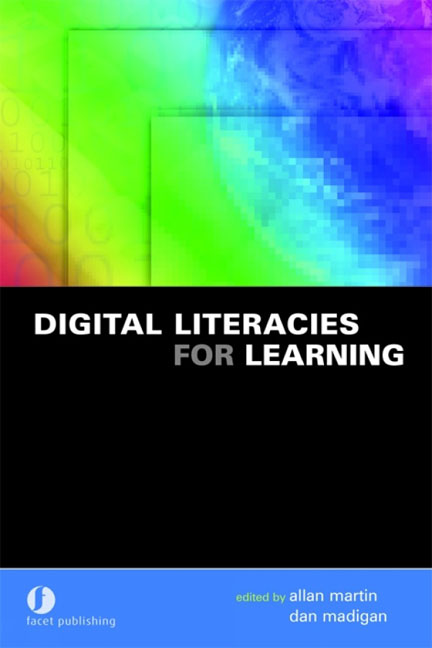Book contents
- Frontmatter
- Contents
- Dedication
- The contributors
- Foreword
- Preface
- Part I Literacies in the digital age
- 1 Literacies for the digital age: preview of Part 1
- 2 Learners, learning literacy and the pedagogy of e-learning
- 3 Real learning in virtual environments
- 4 Digital fusion: defining the intersection of content and communications
- 5 Literacy and the digital knowledge revolution
- 6 Understanding e-literacy
- 7 Information literacy – an overview
- 8 Contemporary literacy – the three Es
- 9 Reconceptualizing media literacy for the digital age
- 10 Literacy, e-literacy and multiliteracies: meeting the challenges of teaching online
- 11 Graduate e-literacies and employability
- Part II Enabling and supporting digital literacies
- Index
9 - Reconceptualizing media literacy for the digital age
from Part I - Literacies in the digital age
Published online by Cambridge University Press: 08 June 2018
- Frontmatter
- Contents
- Dedication
- The contributors
- Foreword
- Preface
- Part I Literacies in the digital age
- 1 Literacies for the digital age: preview of Part 1
- 2 Learners, learning literacy and the pedagogy of e-learning
- 3 Real learning in virtual environments
- 4 Digital fusion: defining the intersection of content and communications
- 5 Literacy and the digital knowledge revolution
- 6 Understanding e-literacy
- 7 Information literacy – an overview
- 8 Contemporary literacy – the three Es
- 9 Reconceptualizing media literacy for the digital age
- 10 Literacy, e-literacy and multiliteracies: meeting the challenges of teaching online
- 11 Graduate e-literacies and employability
- Part II Enabling and supporting digital literacies
- Index
Summary
Abstract
This chapter identifies how media literacy education must adapt to accommodate the changing nature of young people's experience with digital media and new communication technologies. Teachers who traditionally emphasize the processes of analysing news, advertising and entertainment media must expand their focus to include new media (like cellphones and handheld devices), new message forms (like search engines, instant messaging, blogs and online entertainment) and new social issues (including identity and anonymity, privacy and surveillance). By examining certain conceptual principles and instructional practices which may (or may not) support this shift in focus, this chapter examines the process that teachers will experience as they aim to strengthen students’ communication and critical thinking skills as full participants in the digital age.
Introduction
One September morning in a high school just outside Washington DC, Mr Smith, a social studies teacher, started his semester standing at the front of the room full of somewhat sleepy students aged 15–17. The elective course was entitled ‘Media Literacy’ and, as he passed out the course syllabus, he previewed some of the topics and issues that would be explored over the coming months: analysing news media, learning how news is constructed, and understanding media's function in society; analysing advertising including reflections on the processes of consumer socialization and the manufacture of desire; examining patterns of representation of race, gender and class in mass media messages; and understanding the psychological impact of media violence and the role of entertainment violence in con- temporary culture. Through a series of readings, screenings, discussion and writing activities, this teacher's aim was to help students to become critical thinkers in responding to media messages, to understand the social, political and economic contexts in which messages are constructed and disseminated, and to reflect on and examine their own behaviours as consumers and citizens. During the semester-long course, Mr Smith made active use of newspapers, magazines, television news and entertainment programmes, documentaries and curriculum materials he found online and at the Center for Media Literacy's website in Los Angeles.
While still a novelty in most US public schools, media literacy is now beginning to acquire some status within the K-12 content areas of English language arts, social studies and health education (Hobbs, 2004).
- Type
- Chapter
- Information
- Digital Literacies for Learning , pp. 99 - 109Publisher: FacetPrint publication year: 2006
- 5
- Cited by



